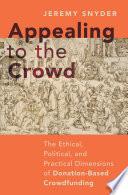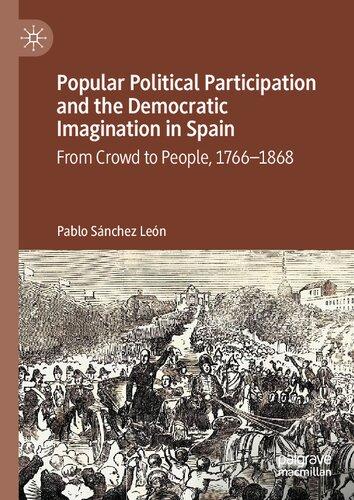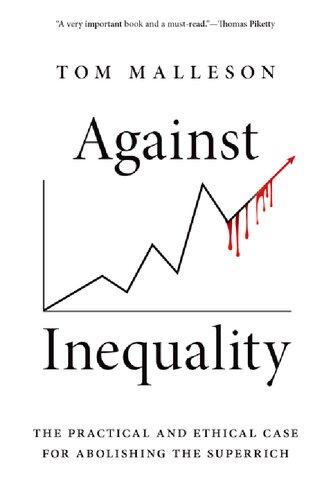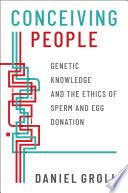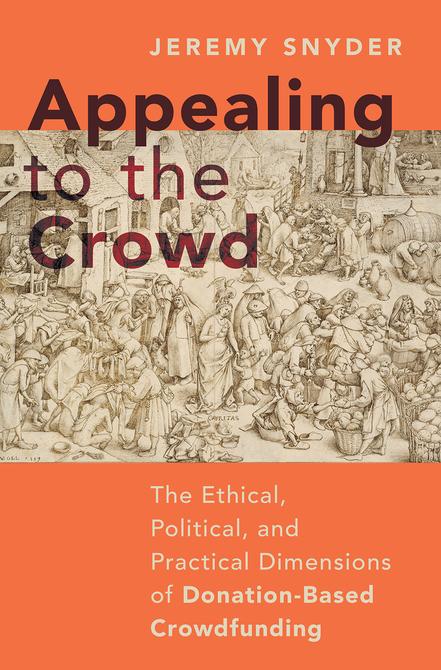Appealing to the Crowd
The Ethical, Political, and Practical Dimensions of Donation-Based Crowdfunding
JEREMY SNYDER
Oxford University Press is a department of the University of Oxford. It furthers the University’s objective of excellence in research, scholarship, and education by publishing worldwide. Oxford is a registered trade mark of Oxford University Press in the UK and certain other countries.
Published in the United States of America by Oxford University Press 198 Madison Avenue, New York, NY 10016, United States of America.
© Oxford University Press 2024
Some rights reserved. No part of this publication may be reproduced, stored in a retrieval system, or transmitted, in any form or by any means, for commercial purposes, without the prior permission in writing of Oxford University Press, or as expressly permitted by law, by licence or under terms agreed with the appropriate reprographics rights organization.
This is an open access publication, available online and distributed under the terms of a Creative Commons Attribution – Non Commercial – No Derivatives 4.0 International licence (CC BY-NC-ND 4.0), a copy of which is available at http://creativecommons.org/licenses/by-nc-nd/4.0/.
You must not circulate this work in any other form and you must impose this same condition on any acquirer.
Library of Congress Cataloging-in-Publication Data
Names: Snyder, Jeremy, author.
Title: Appealing to the crowd : the ethical, political, and practical dimensions of donation-based crowdfunding / Jeremy Snyder.
Description: New York, NY : Oxford University Press, [2024] | Includes bibliographical references and index.
Identifiers: LCCN 2023017330 (print) | LCCN 2023017331 (ebook) | ISBN 9780197658130 (hardback) | ISBN 9780197658154 (epub) | ISBN 9780197658161
Subjects: LCSH: Crowd funding—Moral and ethical aspects. | Electronic fund raising—Moral and ethical aspects. | Crowd funding—Social aspects. | Electronic fund raising—Social aspects.
Classification: LCC HG4751 .C628 2017 (print) | LCC HG4751 (ebook) | DDC 658.15/224—dc23/eng/20230526
LC record available at https://lccn.loc.gov/2023017330
LC ebook record available at https://lccn.loc.gov/2023017331
DOI: 10.1093/oso/9780197658130.001.0001
Printed by Integrated Books International, United States of America
Acknowledgments
Leigh Palmer read and commented on the entire manuscript of this book and helped my research on crowdfunding during countless conversations over the past few years. Iva Cheung edited this manuscript and pushed me to make it better. Thank you to a wide range of audiences who have listened to different facets of my research on crowdfunding over the past few years and helped to clarify and improve my work. Some of the research I drew on in this book was supported by the Greenwall Foundation, the Canadian Institutes of Health Research, and the Social Sciences and Humanities Research Council of Canada. My thinking on crowdfunding was shaped by conversations with people who have used crowdfunding for themselves and their loved ones and by people working in the crowdfunding industry. My work has also benefitted by reading countless crowdfunding campaigns, many of which contain devastating stories of unmet needs. Finally, my wonderful family has always supported me without question, with their only reward being hearing about this topic far more than they would like—thank you and I love you Leigh, Jude, and Merit.
Introduction
Asking for and giving financial help is a normal part of life for most people. A few days before writing this, both of my children emptied their backpacks on the kitchen counter and presented me with forms for their elementary school walkathon. If I agreed to donate to the fundraiser, my kids would join their classmates in walking a certain number of times around their school’s track. The money they earned would go to buying library books and musical instruments for the school. I was happy to make a pledge, and my kids went on to request the same thing from their grandparents. Their grandparents probably remembered when my wife and I had participated in similar fundraisers for our schools and pledged their support, too.
For my kids, the tradition of the school fundraiser this year was made a little more complicated by the COVID-19 pandemic. There was less going around in person to friends and neighbors to seek pledges, and there was a strict requirement that all donations be transferred to the school electronically. The pandemic is probably part of the reason fundraisers among my university colleagues have increasingly moved online as well. Instead of passing around an envelope at an in-person faculty meeting or leaving a collection box out at the front office, recent requests to help a professor fleeing the Taliban takeover of Afghanistan or to pay for the legal fees of a climate change protest took the form of “starting a GoFundMe.”
Online crowdfunding campaigns like these—which in my and many other communities have become synonymous with the GoFundMe brand—have increasingly taken over from offline giving activities. In the recent past, someone needing help to pay for medical treatment might have put a description of their need and a collection tin at the front counter of the local gas station. This kind of community-based crowdfunding is now commonly supplemented or replaced by online forms. While both offline and online crowdfunding involve appealing to community members for donations to directly support an individual or specific cause, the online version of this practice uses social networks to promote the campaign, thus greatly increasing its potential exposure. The online nature of this form of crowdfunding makes
Appealing to the Crowd. Jeremy Snyder, Oxford University Press. © Oxford University Press 2024.
DOI: 10.1093/oso/9780197658130.003.0001
it easier to transfer funds and makes it more likely that people beyond one’s geographically proximate community of acquaintances will learn of the campaign and be moved to donate to support it.
Precise figures on the global scope of crowdfunding can be difficult to find given limited reporting by the platforms that host them. That said, it is clear that this practice has a large and quickly growing global presence. In the United Kingdom, a quarter of all people donated to a crowdfunding campaign between mid-2020 and mid-2021, and younger donors are more likely to participate in this form of giving than older donors.1 The crowdfunding platform GoFundMe, with users across the English-speaking world and much of the European Union, collected $625 million in donations from 9 million donors for COVID-19–related needs between March 1 and August 31, 2020.2 Eighteen percent of Americans donated to health-related crowdfunding campaigns alone in the year leading up to April 2021, and nearly a third of Americans donate to crowdfunding campaigns yearly.3,4 Donationbased crowdfunding (as opposed to reward-based crowdfunding for startup companies or other enterprises) is increasing in Brazil, China, India, Indonesia, and elsewhere.5,6 In upper- and lower-middle-income countries where institutionalized giving is less well established, crowdfunding for individuals is increasing overall participation in giving practices.7
The reasons for this growth in crowdfunding are numerous and to some degree complicated. But the basic appeal is simple: as with other online technologies, it makes a long-standing practice—in this case, fundraising— more convenient. Instead of organizing the transfer of funds in person, crowdfunding takes advantage of electronic funds transfers to make helping out incredibly easy. In the case of the crowdfunding campaign my colleague organized for an Afghan professor, the online nature of the campaign meant that the campaign organizer could easily provide updates on the professor’s journey, including escaping Afghanistan, navigating the Canadian visa process, and, eventually, arriving in their new country safely. Not incidentally, these updates were a good way to encourage continued giving and provide donors with a sense of meaning and accomplishment.
Crowdfunding, then, is in many respects a continuation of long traditions of offline fundraising while taking advantage of online technologies. It makes both giving and receiving easier, streamlining existing giving patterns. Boosters of this form of fundraising have also hyped it as having a transformative effect—including, in tech-sector parlance, “disrupting” traditional giving so that “when you layer asking for help with social media, it turns one
donor into hundreds, even thousands of donors.”8 Former GoFundMe CEO Rob Solomon describes charitable crowdfunding as making up the “giving layer of the internet,” a phenomenon that for the first time combines “ecommerce and social sharing, into something far more democratic and altruistic.”9 Journalists covering this practice report that the technology enabling online crowdfunding extends traditional, analog forms of giving, becoming “the miracle of interconnectedness leading to globalized compassion.”10 This shift online means that campaigners are no longer limited to soliciting help from only their immediate social networks and communities. Instead, campaigns “become unbound” from where campaigners live and “who they knew.”11 As a result, crowdfunding is “turning us all into Good Samaritans.”12
While mainstream philanthropic organizations are also increasingly using online crowdfunding to raise money, the individualized and relatively democratic nature of crowdfunding is framed as being something new and distinct from giving by and through large institutions. Crowdfunding empowers donors to connect directly with individuals they care about. As one crowdfunding executive describes it, “you’re not just giving to an organization that then decides how it’s going to use the funds. [Donors] can say ‘I’m giving to this specific person, I identify with their need.’ ”13 These philanthropic organizations are framed by crowdfunding enthusiasts as being too slow and inflexible, letting down many people in need. Crowdfunding, by comparison, allows campaigners to quickly create a campaign suited to their own needs and use online technologies and social media, tools with which they are already familiar and comfortable. Thus, crowdfunding campaigns, integrated into existing social media platforms, can serve as the “take-action button for the internet”14 or a “digital safety net.”15 Through these online pathways, campaigners can connect with friends, family, and even strangers who might not have participated significantly in giving to traditional philanthropies but are motivated to help specific crowdfunding campaigners.
Online crowdfunding can transform traditional giving practices into something that is easier, faster, more personalized, and more democratic. But the popular press is full of stories charging that crowdfunding’s transformative effects can also be profoundly negative. These include headlines presenting crowdfunding as having a “hidden cost”16 and “dark side,”17 being sometimes “ugly,”18 and acknowledging that crowdfunding has “revolutionized how we give” but questioning whether that is “a good thing?”19
The concerns expressed about crowdfunding vary. In some cases, they aren’t targeted at the practice of crowdfunding specifically but rather at the
necessity of asking the public for help with basic needs. In this view, crowdfunding is a helpful and even lifesaving but necessary evil, symptomatic of the failures of the government, market mechanisms, and even philanthropic institutions to help provide for these needs.
Other criticisms of donation-based crowdfunding target the practice itself, focusing on the observation that making a successful public appeal for support requires making oneself appealing to the crowd. Campaigners must perform for the public to establish their deservingness for financial support. As with other forms of social media, crowdfunding has the “effect of publicizing private struggles.”20 This can include parading vulnerability and need in uncomfortable ways and “revealing intimate details of their life for a chance at having strangers pay their bills.”21 By the logic of this popularity contest for public support, those who do not receive any or enough support are not deserving. This outcome can be deflating for campaigners on top of the suffering that motivated their campaign in the first place. As one campaigner put it, “I suppose if I’d been one of those people who found an abandoned hedgehog and created a backyard sanctuary for hedgehogs and asked for $50 and got $100,000, I’d be super happy with GoFundMe. But all I’ve done is expose myself.”22
While crowdfunding can be enormously helpful for some people, it also does little for many and generally fails to address the underlying causes of these needs. So-called viral campaigns get a great deal of publicity and are promoted as uplifting public interest stories demonstrating the goodness of people who come together to help someone in need. In reality, most crowdfunding campaigns fail to meet their goals, and many do not receive any donations at all. Distributing funding in this way creates a “marketplace of compassion, which is what crowdfunding sites amount to,” and which “produces winners and losers like any other marketplace,” meaning that “everyone must beg to survive, and most will not beg well enough.”23
People with large and wealthy social networks have an advantage in the interconnected environment of online crowdfunding. While people with smaller or poorer networks can also go viral in online crowdfunding, factors like telling a sympathetic story or catching the eye of an online influencer help determine success such that “whoever has the most heartrending story wins.”24 Campaigns typically focus on immediate and superficial needs rather than their underlying causes. As such, campaigns can be “wellintentioned” but “cringeworthy” when raising funds, ignoring structural causes of need while positioning the campaigner as a “white savior” stepping
in to help those in need.25 As the CEO of the Canadian crowdfunding platform FundRazr acknowledged, “Crisis stories work so much better than chronic stories,” meaning that some kinds of needs are more likely to receive public support than others.26
The online nature of crowdfunding reduces barriers to creating campaigns and allows donors greater decision-making over which individuals and causes they fund. This democratic aspect of crowdfunding is positive in many ways but also raises concerns that harmful and fraudulent campaigns will be funded as a result. This harm can include fundraising for campaigns that rely on hateful attitudes toward others or illiberal political goals, like anti-immigrant political campaigns and efforts to end marriage equality. Anti-science misinformation is also promoted on these platforms, including anti-vaccine misinformation that is popular on social media channels and, via crowdfunding, backed with financial support. Although crowdfunding platforms vet campaigns to some extent, campaigners are free from the typically more rigorous vetting by state institutions and philanthropic institutions and can simply lie about their needs. As a result, crowdfunding is accused of enabling “scams on a massive scale.”27
Aims and plan for the book
My focus in this book is on crowdfunding for basic needs like housing, food, medical care, and education. While donation-based crowdfunding is also used to raise money for honeymoons and religious mission trips, among many other things, these kinds of activities generally fall outside the scope of the book. My first aim for this book is to look critically at the ethical, political, and practical dimensions of donation-based online crowdfunding against a backdrop of traditional giving practices. These traditional practices include giving directly to individuals and indirect giving through intermediaries such as nonprofit organizations. Crowdfunding has genuine advantages over some aspects of these traditional forms of giving. At the same time, it reproduces and deepens some of the shortcomings of traditional forms of giving while also introducing new concerns.
My second aim for this book is to suggest ways to shape and engage with donation-based crowdfunding more responsibly. In doing this, I situate crowdfunding as a practice that has a strong appeal to many people and is growing worldwide. While we might prefer that people’s basic needs be met
as entitlements through the state or philanthropic institutions that focus on long-term social reforms, crowdfunding is and will remain part of the fabric of giving practices. Crucially, crowdfunding does provide genuine benefits, particularly in the absence of fully just political and social institutions. But, as currently practiced, crowdfunding is deeply problematic in how it supports giving.
In achieving these aims, we will encounter a range of challenging philosophical questions, including “What is the role of the state in meeting basic needs?,” “How should we conceive of the values of privacy and dignity?,” and “How should individuals set priorities in giving to others in need?” In this book, I introduce these debates in terms of how they relate to giving practices, but I avoid taking a deep dive into or defending a particular position within these debates. I’m choosing this approach because, first, I want to focus on the many ethical, political, and practical dimensions of crowdfunding specifically rather than individual giving more generally. Second, this approach will help me develop a widely acceptable argument about the most responsible uses of crowdfunding by establishing areas of broad consensus about, for example, the value of personal privacy and need for individual giving under conditions of injustice. Finally, I hope that this book has a wide audience including academic philosophers, applied ethicists, and social scientists, but also the wider public working in the fundraising and philanthropy sectors or simply interested in the practice of crowdfunding. I believe that this shallower discussion of philosophical debates in favor of a deeper discussion of the pragmatics of crowdfunding can engage and serve all of these audiences.
In Chapter 1, I place donation-based crowdfunding in the context of traditional giving practices. I give an overview of the development of donation-based crowdfunding and the advantages it provides for donors and campaigners. These advantages are particularly due to crowdfunding’s integration into online social media environments, which empowers campaigners to direct their own fundraising activities and to reach a much wider audience of potential donors than is generally the case through offline fundraising. This expansion and democratization of giving through crowdfunding supports a line of critique against institutional intermediaries like philanthropic organizations. Whereas crowdfunding seemingly allows campaigners to identify their own needs and individual donors to choose individuals to help, philanthropic intermediaries are often slow to act, are
dominated by wealthy and otherwise advantaged community members, and create barriers to individuals’ ability to receive help.
Despite these advantages of crowdfunding over traditional forms of giving, the bulk of this book examines the new and expanded ethical, political, and practical issues created by crowdfunding. Many of these concerns are connected to the online nature of crowdfunding, which impacts the privacy of campaign recipients (Chapter 2) and puts these recipients in the position of having to establish their worthiness to receive help (Chapter 3). Online crowdfunding does democratize giving, but there is also strong evidence that the public chooses to support recipients who are already relatively advantaged in terms of wealth, education, racial privilege, and other factors (Chapter 4). This individualization of giving further pulls the public’s attention from systemic causes of need, instead focusing on individuals and presenting crowdfunding campaigns as a solution to systemic need and social injustice (Chapter 5). The removal of intermediaries from giving also creates new opportunities to engage in fraudulent campaigning (Chapter 6) and spread misinformation, promote hateful causes, and engage in other harmful fundraising activities (Chapter 7). Chapter 8 demonstrates how these concerns were made vivid during the COVID-19 pandemic, a period of rapid growth in crowdfunding activity while also an illustration of its many shortcomings.
These chapters take largely for granted that, for better and for worse, donation-based crowdfunding removes intermediaries from giving, thus devolving oversight and decision-making to donors and campaigners. Chapter 9 complicates that picture by examining how crowdfunding platforms like GoFundMe serve as intermediaries between donors and recipients, shaping which campaigns rise to the public’s attention and how campaigns must be presented to be successful. At the same time, crowdfunding platforms are increasingly providing the infrastructure for philanthropic organizations to raise money online. Thus, the advantage of crowdfunding over indirect giving through intermediaries is largely overstated and declining. In the conclusion of this book, I draw lessons from this observation and the other chapters to argue for guiding values for crowdfunding and practical steps to promote the genuine benefits of this practice while reducing some of its many negatives. Although we don’t have to accept or engage with crowdfunding as it is, we do need to take seriously the growing size and appeal of this practice to engage more responsibly with crowdfunding.
One note on the excerpts of crowdfunding campaigns quoted in the book: where these excerpts are taken directly from crowdfunding campaigns, including at the beginning of Chapters 1 through 8, I don’t include a citation to that campaign to protect the privacy of campaigners who may feel compelled to share their stories with the public—an ethical issue I describe in Chapter 2. An exception to this approach is citations of different versions of a specific campaign that I describe in Chapter 8 and that received extensive media exposure. In other cases, quotations are taken from news media and scholarly outputs, and citations are given in these cases.
When I first began writing on donation-based crowdfunding in 2016, very little had been published on this topic, especially around its ethical and political dimensions. This is not surprising, given the relative recency of online crowdfunding and the timeline for capturing the attention of scholars and producing and publishing research on any topic. Since then, however, scholarship on donation-based crowdfunding has taken off, drawing insights from a wide variety of disciplines. This book synthesizes and advances much of that output, giving an overview of the advantages and perils of the rapidly growing online crowdfunding sector.
Crowdfunding as a practice will continue to evolve and expand worldwide, as its more recent turn toward intermediated giving demonstrates. While individual, platform, and public policy responses to these changes will need to evolve as well, the suggestions offered here serve as a starting point for shaping a rapidly growing practice that will continue to influence how giving takes place worldwide.
Giving and the rise of crowdfunding
THANK YOU everyone for your generosity. Every dollar has made a difference and is greatly appreciated. . . . Three different times I was certain I would need to redirect funds to Mom’s burial expenses, but then at the last moment she would rebound. Three times. That was not fun. However, as I said, being able to take care of a few issues for them, without having to deal with financial stress over it, was a godsend for everyone.
The giving practices of people who aim to support others’ basic needs have varied across cultures and throughout history. Understanding the arguments for and against some of these traditional giving practices can offer context for the recent development of online donation-based crowdfunding. Crowdfunding mirrors many of the benefits, limitations, and drawbacks of these other giving practices. At the same time, crowdfunding includes distinctive advantages and shortcomings that can only be understood through the context of other giving practices.
Throughout the book I draw a broad distinction between (1) giving by individuals directly to those in need or to their agents and caregivers with the aim of addressing their basic needs and (2) giving by individuals indirectly, to groups or organizations that act as intermediaries to distribute these resources to those in need. In the first category of direct giving, I include direct gifts to people for their benefit, such as giving spare change to a person experiencing homelessness to buy lunch or purchasing tickets for a concert benefiting a specific person who needs money for a medical treatment. On this understanding, direct giving overlaps with religious practices of almsgiving to poor people. The second category of indirect giving includes, for example, donations to support a soup kitchen that feeds many hungry people in a specific area or giving to a nonprofit organization promoting democratic reforms in a foreign country. Giving indirectly through an
Appealing to the Crowd. Jeremy Snyder, Oxford University Press. © Oxford University Press 2024.
DOI: 10.1093/oso/9780197658130.003.0002
intermediary can address immediate needs or longer-term, structural changes that focus on the underlying causes of these needs.
Giving by individuals may not always fall easily into these two categories of direct and indirect giving; some cases could arguably fit into either or neither category. That said, for the purposes of this book, the distinction between giving directly to individuals versus giving through intermediaries marks different practices that raise different ethical, political, and practical concerns. As I argue in Chapter 9, online donation-based crowdfunding has been treated largely as direct giving. However, crowdfunding platforms are increasingly serving as intermediaries as well. This evolution is crucial to understanding the ethical dimensions of crowdfunding and suggesting ways to address problems within the practice of crowdfunding.
Ethical arguments for giving
There is a wide consensus in Western philosophical ethics that giving to others to support their basic needs is at least morally praiseworthy and to a large extent morally required. Ancient and contemporary accounts of virtue typically include discussions of how to approach our own wealth, including giving a portion of it to support others. For Aristotle, the virtue of liberality describes a mean, understood as acting in the right way, with regard to the practice of giving and getting wealth. Virtues, on this account, are deeply ingrained character traits that are given shape through our actions and responses to the world. The virtue of liberality is bookended by two vices or extremes with regard to giving and receiving wealth: prodigality, or excess giving, and stinginess, or deficiency in giving. A liberal or virtuous person, according to Aristotle, gives for “the nobility of giving” or for its own sake rather than for the praise, thanks, or other benefits of giving. The mean in giving our wealth to others can be found in the person who gives “to the right people, the right amount, and at the right time.”1 The right amount of giving will depend in part on the resources of the giver. For Aristotle, a liberal or virtuous person will tend not to be rich as they will give their wealth to others regularly and value wealth for the ability to give it to others rather than for its own sake. Giving to the “right people” is not simply a matter of giving to the poor indiscriminately, for the prodigal person will “make men rich who ought to be poor, and will not give anything to the worthy, while heaping gifts on flatterers and others who minister to their pleasures.”2 For Aristotle,
reducing poverty is not in itself the aim of liberality, then; rather, liberality is a matter of giving to those who are worthy of receiving wealth. While differing in the details of what forms of giving count as achieving the mean, contemporary or neo-Aristotelian accounts of virtue ethics similarly consider how we should use our resources to help others.3,4
David Hume picks up on the centrality of human character to morality in virtue ethics but in a significantly different way from Aristotle. Hume argues that benevolence, understood as concern with the welfare of others, is fundamental to both human nature and morality. This connection to human nature allows for universality in how we respond to certain events and objects—what Hume calls virtues. Hume catalogues virtues according to their usefulness and agreeableness to ourselves and others. This catalogue includes a category of virtues centering on mental qualities that are useful to others, among which is the virtue of charity. As Hume states, “Giving alms to common beggars is naturally praised; because it seems to carry relief to the distressed and indigent: But when we observe the encouragement thence arising to idleness and debauchery, we regard that species of charity rather as a weakness than a virtue.”5 Thus, giving to those in need is virtuous insofar as it is useful in relieving suffering. When such giving encourages the recipient to turn down income from working or to feed substance use, it is not useful to the recipient or society and is thus not a virtue.
For Hume, the usefulness of giving speaks in large part to our sentimental reaction to these actions. Efficacy is at the heart of utilitarian arguments around giving as well in that the value of helping others should be judged by the outcomes of the gift, with emphasis on creating the best or most effective outcomes possible in terms of relieving suffering or improving welfare. The canonical utilitarian approach to assessing the value of gifts is given by John Stuart Mill, who argues that the value of actions should be assessed by their outcomes. Creating goodness in the world, understood as increased welfare, is the single principle of right and wrong. This understanding of the value of giving can be highly demanding in that it requires that we do the most good through our actions, with less beneficial actions deemed morally inferior.6
More recently, this utilitarian approach has given rise to the effective altruism movement. Effective altruism urges people to assess the value of giving to others based on the outcomes of these gifts. Effective altruism is particularly associated with Peter Singer, who has articulated a range of stronger and more moderate versions of a broadly utilitarian view that we ought to give our excess resources to others, with a focus on doing the most
good possible through these transfers.7 For Singer and others in this vein, giving to this extreme and with the focus on the efficient use of resources is not a simple kindness to others or an optional matter of choice; rather, it is a basic requirement of morality. Significant disagreements exist over which forms of giving are most effective, including whether to prioritize giving to charitable organizations offering various forms of poverty relief or political and policy organizations aiming to reform unjust international institutions.8 Nonetheless, the general emphasis is on maximizing good for others through giving with a focus on outcomes. Assessments of these outcomes are generally impartial as to which individuals receive these benefits, including when and where they are received, instead focusing on the quantifiable good done by the action.
While utilitarianism and related ethical traditions focus on outcomes, others put greater emphasis on the motivation behind giving. Immanuel Kant argues that we all have duties to others, which include duties of practical love, understood as promoting others’ happiness. This duty takes the form of promoting the permissible ends of others, which can be achieved in various ways depending on others’ ends. Given the basic needs of humans for survival, pain-free living, and good health, supporting these basic needs will nearly always be a form of supporting others’ permissible ends.9 Supporting others’ basic needs is not the only way to discharge this duty of beneficence, but where others lack basic supports, helping to support them generally counts as a means of acting in accordance with this duty.
A Kantian duty of beneficence is generally understood as an imperfect duty, meaning that one has some discretion in terms of who, when, and to what degree to help others. While there is some choice as to whom one gives aid, Kant is clear that giving to others is a requirement and not simply optional when assessed over the full course of one’s life. As he describes it, “[b]eneficence to others must rather be commended as a debt we owe, than as a piece of kindness and generosity; and so it is in fact; for all acts of kindness are but small repayments for our indebtedness.”10 One’s context can help to specify this general duty of beneficence. For example, disregarding those in immediate need of help for survival where one is specially or uniquely positioned to help can demonstrate disregard for their humanity. At the same time, Kant is generally understood as allowing partiality to the happiness and needs of friends and family insofar as one can wish for others’ happiness universally but act specifically to support the happiness of those of most concern to oneself.11
In practice, these broad approaches to the duty to give to others differ enormously over how much, when, and to whom we must give. Virtue-based approaches emphasize a median in giving in the “right” amount and to the “right” people, while broadly Kantian traditions emphasize the intention behind giving, in contrast to effective altruists’ focus on best outcomes. These camps agree, however, that some giving to meet others’ basic needs is required of us. Some particularly strong liberty- and property-based accounts of ethics make control over one’s resources absolute and giving to others purely optional, but these accounts are largely outliers within Western philosophical ethics—and, even in those cases, giving is generally discussed as a personal obligation that should be free from state coercion rather than something that is purely optional.12
While there is disagreement about the scope and targets of giving in Western philosophical ethics, in practice a range of factors help to determine where people tend to focus their giving. Donors typically view their giving as more akin to an imperfect Kantian duty in that they have discretion as to when, how, and whom to help.13 In other cases, giving is viewed as supererogatory—something that is praiseworthy but not morally required.14 In high-income countries, people tend to prefer giving to local rather than international charities, even when these international charities are in lowincome settings where donations are likely to have a greater positive impact.15 Personal connections and empathy with potential recipients help to direct giving, as when the donor or a loved one has experienced the same medical condition as the recipients.16 Even when donors are given information about the likely outcomes of different giving options, people tend to prioritize giving based on personal preference and connections rather than the efficacy of the gift.17
In short, there is significant diversity in ethical arguments about why one ought to give to others and a wide gulf between most of these arguments and the actual practice of giving. Online crowdfunding can accommodate any of these approaches. An effective altruist, for example, can choose to use a crowdfunding platform to support a philanthropic organization that efficiently uses these donations to address long-term threats to humanity’s well-being. In practice, however, crowdfunding has typically emphasized giving to individuals in ways that are ill suited to the requirements of effective altruism and other outcome-focused ethical approaches. This might suggest a more relational approach to giving in the practice of crowdfunding. However, as I show in later chapters of this book, giving in
crowdfunding often does not follow any of these ethical approaches but is typically more impulse-based.
Direct giving
When individuals give directly to other individuals, recipients can include the person in need or their caregivers or agents acting on their behalf, such as a friend or parent. In this section I include examples of some religiously mediated practices of giving, focusing on giving directly to individuals (though these practices also motivate giving to institutions, including religious institutions, for poverty relief). My aim is not to give a comprehensive overview of giving practices worldwide or throughout history. Instead, I offer a broad sampling of giving practices and their motivations in order to contextualize criticisms of direct giving. These criticisms have encouraged a shift to more institutionalized practices of indirect giving.
Among many Indigenous communities, giving to others is shaped primarily by relationships of reciprocity rather than through the aim of relieving poverty. Giving in these contexts is not primarily an expression of selfless altruism but part of a web of mutual obligations and relationships.18 In Indigenous South African communities, for example, giving to others is treated as a more equitable or horizontal practice rather than a hierarchical interaction between rich and poor. In these communities, giving is often governed by norms of solidarity, caring, and shared humanity. This form of giving takes place among both relatively rich and less wealthy individuals. In part, given the material constraints of less wealthy people, these giving practices can include giving nonmaterial goods, such as donating one’s time to look after a sick neighbor.19 To take another example, giving practices among many First Nations peoples in North America often emphasize community connectedness and de-emphasize the needs of specific individuals in favor of stressing a larger cosmological and historical story of their people.20 Thus, these giving practices may not emphasize or create status differences within these communities.
This nonhierarchical and reciprocal conception of giving in some Indigenous communities is also framed in terms of a drive toward mutual aid. 21 A key element of mutual aid is captured in the slogan “solidarity not charity.” On this view, giving in the form of charity is typically guided by the priorities of wealthy people or the government rather than people in need of
aid. Furthermore, charity tends not to address the systemic causes of poverty, violence, and inequality. By comparison, giving as a form of mutual aid seeks a shared understanding of why some people are struggling to meet their basic needs while others have much more than they require. Mutual aid takes this knowledge about root causes of need and channels them into political movements to change social systems. Rather than dividing people into deserving and underserving groups when addressing these needs, the value of solidarity in this context stresses universal connection and participation in social movements. Social movements connected to mutual aid are intended to be widely participatory and include people in need rather than taking on a more passive form controlled by relatively privileged donors.22 In these ways, mutual aid activities take on the nonhierarchical nature of some Indigenous giving practices while also taking on a deeply political and reform-based ethos.
Among elites in ancient Greek and Roman communities, giving was generally tied to expressions of citizenship—for example, paying for public works and the entertainment of fellow citizens. When giving took place between individuals, this practice could focus on how giving bound them together and created relationships of reciprocity.23 The Roman philosopher Seneca, for example, writes that giving creates an ongoing relationship of equality. A loan from a creditor can simply be repaid and the relationship of obligation ended. However, with a gift or benefit “even when I have repaid his kindness we remain connected, for when I have paid my debt I ought again to renew it, while our friendship endures unbroken.” As a result, Seneca argues, we must be careful in choosing from whom we receive gifts and to whom we give them. Because these gifts give rise to friendship and love, he says, it is “wretched . . . to feel it to be his duty to love one whom it does not please him to love.”24 On these views, worthiness in giving or receiving a gift is not based on the good that gift will do or the suffering it will relieve but rather on the obligations and relationships it will generate.
Religious traditions, of course, also have had an enormous impact on shaping norms around direct forms of giving. Within Judaism, there are numerous provisions requiring giving to the poor. These include requirements to leave the edges and gleanings of fields for the poor to gather,25 which is justified in part on the basis that the Jewish people were once destitute slaves in Egypt in need of aid.26 Other commands of giving to the poor include giving a tithe or 10% of one’s produce every three years to foreigners, the fatherless, and widows.27 More generally, how much to give to others in the Jewish
tradition depends on how much is needed, with a broad requirement to meet others’ needs.28
Later interpretations of the Hebrew Bible expanded the concept of tzedakah, or justice, which included giving by individuals to aid the poor. In addition to regular, obligatory payments of tzedakah akin to tax payments, giving directly to individuals was typically seen as required. One interpretation of this form of giving derives from Moses Maimonides’s description of eight degrees of tzedakah, which differentiate between more and less praiseworthy forms of giving. At the top of this ladder is giving that enables another person to find work or otherwise no longer need aid. Lower on this ladder, giving where the giver and receiver do not know one another’s identity is still valued. Direct giving of this kind can help protect against disreputable charitable organizations wasting funds and protect recipients from what Maimonides views as the humiliation of receiving charity. Lower forms of giving speak to the problematic motivations of the giver, including giving only after being asked to do so, giving less than needed, and giving reluctantly.29
Many early Christian thinkers stressed giving to others by virtue of their shared humanity and common creator.30 This understanding of the role of direct giving among early Christians broadly echoes the lessons of Christ in the Gospels: Christ was said to have been born into poverty and, in the words of his disciples, connected sin to wealth and goodness to giving funds to the poor. In particular, the Christian practice of giving alms created a longstanding expectation that all Christians would use their wealth to relieve the suffering of the poor. To make this point, Saint Augustine of Hippo wrote that it was acceptable for there to be rich people, but only if they are generous to and share their wealth with the poor around them.31
Other early Christian thinkers advocated for discrimination in terms of which people should receive gifts of alms. Saint Ambrose of Milan, writing in the fourth century, warned against giving to those who make a show of being poor: “people who are in perfectly good health—and they come along with no good reason other than the fact that they spend their lives wandering from place to place, and their intention is to use up the supplies intended for the poor.”32 People deserving help included those who cannot work because of ill health or who lack their freedom—for example, prisoners of war. Ambrose justified this discrimination in largely practical terms, warning against giving too little but also being overly wasteful or generous with resources such that the poor who come later cannot be helped. Later Christian thinkers built on
Ambrose, suggesting that priority should be given to helping one’s family and those known to the almsgiver. Helping strangers was permitted, but only if it would not harm them. Helping nondisabled strangers who could work was viewed as a harm of almsgiving as it would encourage idleness and dependency on charity.33 Early Reformation thinkers put giving in the context of stewardship of property, viewing material wealth as a gift from God for one’s own enjoyment but also for the purpose of healing one’s neighbors.34 For Calvin, giving to others was an expression of love for them as “in regard to everything which God has bestowed upon us, and by which we can aid our neighbour, we are his stewards, and are bound to give account of our stewardship.”35
For Muslims, the Quran commands that the faithful be good to their parents and kin, orphans, and the needy.36 Among the five pillars or core obligations of Islam is zakat, the giving of alms calculated by the individual’s wealth. Zakat is understood as an act of purification of the sins of the giver; failure to discharge this obligation merits punishment. This act of giving can be targeted to help the poor, relieve debts, ransom slaves, support travelers, and urge conversions to Islam. During Ramadan, obligatory Zakat al-Fitr supports poor Muslims in celebrating Eid al-Fitr. Beyond the obligations of zakat, Islam encourages voluntary giving or sadaqa over and above the obligations of zakat. These gifts can target the same recipients as zakat and also serve to remove sin.37 These forms of giving are justified in part because one’s ability to earn a living and very life are due to God’s goodness. Just as God has shown generosity, each person owes a reciprocal duty to share with others so that they may live well.38
In Hindu, Buddhist, and Jain traditions, dāna is a religiously mediated practice of giving away one’s wealth. In general, the practice of charity in these traditions is unilateral in the sense of not including an expectation of reciprocity. For example, the Bhagavad Gita differentiates between giving without expectation of a return and less praiseworthy forms of giving, including when reciprocation is expected or the gift is given grudgingly, with disdain, or to unworthy people.39 Giving to one’s benefactor would thus tend to violate the ideal of giving in these traditions. Instead, the best forms of giving demonstrate disinterest in the potential material advantages of giving even though the act itself may give pleasure. Giving to others may also express meritorious disregard for material goods and serve as a means of unburdening oneself from these goods. Deservingness on the part of the recipient of a gift is typically tied to religious merit. Thus, Brahmans, monks,
nuns, and other religious devotees are particularly worthy targets of giving because they have relinquished material goods. Importantly, these figures are typically unable to reciprocate a gift in material ways. Thus, giving to them avoids tainting the gift with expectations of reciprocity and affirms the pure intentions of the giver.40
These traditions of giving directly to others, along with many other practices, aim at some mix of helping those in the giver’s community, establishing or avoiding relations of reciprocity, and discharging religious and ethical obligations. Through these gifts, countless lives have been saved and enormous suffering has been reduced. However, these traditions of giving have also been a target of criticism, often by those who advocate different norms around or practices of charitable giving.
As seen above, giving traditions differ in whether the relationship between giver and recipient is relatively horizontal or hierarchical. Particularly in highly hierarchical giving relationships, direct giving can treat the recipient in harmful or disrespectful ways. For example, Kant argues that direct giving can in some cases be demeaning to the poor and act more as an expression of the giver’s pride rather than as a true act of beneficence. In these cases, the recipients of alms “are demeaned by it. It would be better to think out some other way of assisting such poverty, so that men are not brought so low as to accept alms.”41 This concern that charity is humiliating to the receiver is echoed in Maimonides’s praise of forms of charity where the giver does not know the identity of the receiver so that the receiver can be protected from humiliation.42 We can reasonably ask whether recipients of charity ought to feel humiliated by these practices and note that norms around self-sufficiency are problematic, mask social injustices, and favor nondisabled people and other relatively socially advantaged groups. Nonetheless, forms of charity that reinforce direct contact between the giver and recipient can harm the recipient. This is particularly true in communities where receiving help is seen as humbling, recipients are sorted into deserving and undeserving groups, and direct giving reinforces deep asymmetries in power and social position.
As Kant’s focus on the giver’s pride shows, the intention behind giving can itself be problematic as well. This concern is reflected in giving traditions that favor anonymity between the giver and receiver or make reciprocity between giver and receiver impossible. In these traditions, the act of giving should be selfless and an expression of the value of giving or some other ethically acceptable intention rather than of hope for personal benefit. Thus, extravagant public giving with an eye toward receiving praise and recognition is contrary
to giving for its own sake. This valuation of giving stands in contrast to more reciprocal traditions such as those found in ancient Greece and Rome, where the point of giving is in part tied to the concrete and personal relationships it creates. Notably, however, these reciprocal traditions are meant to create bonds between community members and are often less hierarchical. Thus, concerns with the intention behind giving are typically located in expressions of the superiority of the giver over the receiver or a disregard for the receiver’s good in favor of personal aggrandizement.
Direct giving can also be criticized for its outcomes, including making giving seem optional, not requiring sufficient amounts of giving, and not making efficient use of gifts. This is broadly Peter Singer’s critique when he argues that because “giving money is regarded as an act of charity, it is not thought that there is anything wrong with not giving. The charitable man may be praised, but the man who is not charitable is not condemned.”43 When one is thanked or praised for giving to others, it’s implied that they might reasonably have declined to give without condemnation. Importantly, in many of the arguments for and practices of giving described above, giving to others is not seen as optional. Nonetheless, a critic in Singer’s vein might argue that many practices of charity do not demand enough of us and that our language around giving tends to reinforce the idea that giving on the scale that Singer supports is not obligatory. Similarly in this regard, direct giving can be focused on existing relationships with individuals or based on the whims and preferences of the giver. While doing some good, giving in this way may do less good than a more institutionalized and intentional form of giving. In particular, giving that is unfocused and not driven by achieving maximally good outcomes may focus on the most visible and sympathetic displays of need rather than sustainably addressing the most substantial and pressing needs.
Indirect giving
Cultural and religious traditions encourage various forms of giving directly to individuals. Giving also regularly takes the form of supporting institutions that act as intermediaries to help address the public’s basic needs. In part due to the criticisms against direct giving summarized above, giving within religious and secular traditions has also emphasized supporting institutions because of their potential for greater and more sustainable positive impacts.
Giving mediated through philanthropic institutions could address at least some of the concerns with direct giving, particularly that giving creates degrading relationships and does not focus on achieving long-lasting, positive effects.
Religious institutions have historically served as philanthropic intermediaries between givers and receivers. Among Christians, while alms were often given directly to those in need, wealthy landowners during the medieval period in Europe also frequently gave to monasteries, religious orders, and other institutions that would use this income to carry out their missions of aiding the poor.44 The Late Middle Ages in Europe saw increased giving to fund institutions aimed at poverty relief generally and helping specific impoverished groups. This shift was in part due to the greater use of wills and last testaments, motivated by dying people seeking redemption for their sins. Institutions supported through wills and other gifts included hospitals aimed at housing and caring for the poor and leper houses for those suffering from leprosy; later, institutions for other specific disease types would be more commonly funded.45 Among Jews in Europe during the medieval and early modern periods, restrictions on owning property and supporting Christian charitable organizations encouraged giving to a range of private Jewish philanthropic organizations to aid the poor, ransom captives, and support Zionist resettlement projects. In some cases, these institutions paralleled Christian facilities such as hospitals, almshouses, and orphanages but targeted Jewish residents.46 For Muslims, while zakat payments can be given directly to individuals, this religious obligation is commonly discharged by establishing or giving indirectly through philanthropic institutions. Moreover, sadaqa, or voluntary giving beyond the requirements of zakat, can be performed by endowing philanthropic entities known as waqfs that use the revenue from property to benefit others. Waqfs can be used to benefit people, buildings, or institutions, and they can last over generations. In many cases waqfs have explicitly religious goals, like when they endow religious institutions or activities. In other cases, educational or health benefits for the community are the aim.47
Economic changes have encouraged indirect giving practices as well. The Industrial Revolution created massive wealth in the hands of a small group of industrialists while also encouraging inequality and urban poverty. Many of these industrialists sought to establish philanthropic foundations out of a sense of religious mission, to improve their reputations during their own lives and after their deaths, and to ward off regulatory actions and other
responses to the concentration of wealth and power in their hands. More recently, tech entrepreneurs have continued this practice, donating to existing philanthropies and financing new foundations to carry out a variety of broadly philanthropic missions, including conducting basic research, providing healthcare, building housing, funding the arts, and conserving the natural environment.48 These are not purely Western developments, as industrialization, the rise of the tech sector, and increased wealth have seen wealthy entrepreneurs form philanthropic foundations in China, South Asia, and elsewhere globally.49 While giving to and establishing philanthropic foundations are in many cases motivated by religion, these foundations may also offer a secular alternative to religious philanthropic institutions and pursue a humanist mission rather than a religious mandate. Similarly, these foundations can offer an alternative to state support for basic needs, even in the context of the social welfare state, by addressing perceived gaps in state support domestically, helping those in need in less wealthy nations, and funding needs and activities not supported by the state.50
Aiding others indirectly through philanthropies, given their scope, longevity, and institutional expertise, could address some of the chief shortcomings of direct giving. Whereas giving directly to others can be intermittent, unfocused, and humiliating, philanthropic institutions can be administered on a more systematic basis that allows funding to be used more efficiently, impersonally, and equitably. This is in part because it enables funds to be spread to a larger community of people on a sustained basis, directed by interests in maximizing the good produced by this funding, and leveraged to encourage longer-term policy changes that reduce the need for philanthropic giving over the long term.
However, giving mediated through philanthropic institutions raises its own problems. One perceived advantage of private philanthropy over the public provision of basic entitlements is that it allows for individual donors to exercise their free choice over how to dispose of their property and, potentially, to meet the public’s basic needs more efficiently than can the public sector. But even if this were the case, Eric Beerbohm argues for the necessity of public involvement in carrying out the requirements of justice. Beerbohm argues that distributive obligations are agent relative, meaning that they can’t simply be outsourced to philanthropists. Collective action by democratic citizens has an expressive value, including an expression of solidarity, that is lost if philanthropic institutions take on the work of distributive justice without the participation of the public citizenry. Put simply, justice doesn’t
